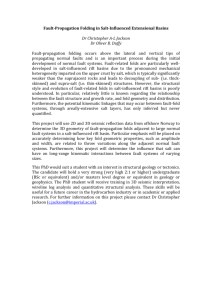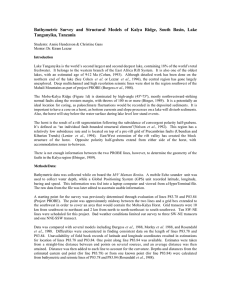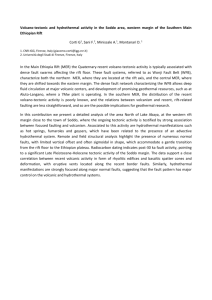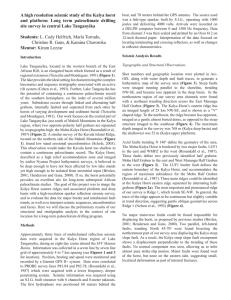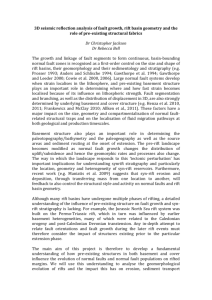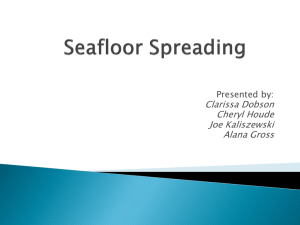Bathymetry and Structure of the Kalya Horst Region, South Basin,
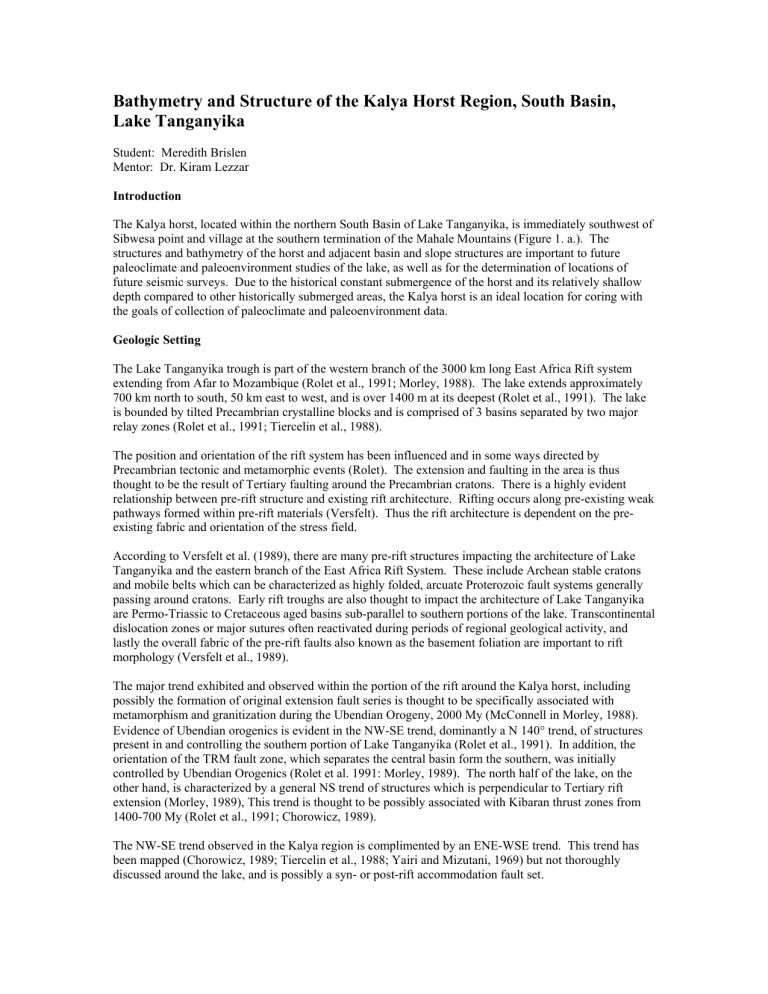
Bathymetry and Structure of the Kalya Horst Region, South Basin,
Lake Tanganyika
Student: Meredith Brislen
Mentor: Dr. Kiram Lezzar
Introduction
The Kalya horst, located within the northern South Basin of Lake Tanganyika, is immediately southwest of
Sibwesa point and village at the southern termination of the Mahale Mountains (Figure 1. a.). The structures and bathymetry of the horst and adjacent basin and slope structures are important to future paleoclimate and paleoenvironment studies of the lake, as well as for the determination of locations of future seismic surveys. Due to the historical constant submergence of the horst and its relatively shallow depth compared to other historically submerged areas, the Kalya horst is an ideal location for coring with the goals of collection of paleoclimate and paleoenvironment data.
Geologic Setting
The Lake Tanganyika trough is part of the western branch of the 3000 km long East Africa Rift system extending from Afar to Mozambique (Rolet et al., 1991; Morley, 1988). The lake extends approximately
700 km north to south, 50 km east to west, and is over 1400 m at its deepest (Rolet et al., 1991). The lake is bounded by tilted Precambrian crystalline blocks and is comprised of 3 basins separated by two major relay zones (Rolet et al., 1991; Tiercelin et al., 1988).
The position and orientation of the rift system has been influenced and in some ways directed by
Precambrian tectonic and metamorphic events (Rolet). The extension and faulting in the area is thus thought to be the result of Tertiary faulting around the Precambrian cratons. There is a highly evident relationship between pre-rift structure and existing rift architecture. Rifting occurs along pre-existing weak pathways formed within pre-rift materials (Versfelt). Thus the rift architecture is dependent on the preexisting fabric and orientation of the stress field.
According to Versfelt et al. (1989), there are many pre-rift structures impacting the architecture of Lake
Tanganyika and the eastern branch of the East Africa Rift System. These include Archean stable cratons and mobile belts which can be characterized as highly folded, arcuate Proterozoic fault systems generally passing around cratons. Early rift troughs are also thought to impact the architecture of Lake Tanganyika are Permo-Triassic to Cretaceous aged basins sub-parallel to southern portions of the lake. Transcontinental dislocation zones or major sutures often reactivated during periods of regional geological activity, and lastly the overall fabric of the pre-rift faults also known as the basement foliation are important to rift morphology (Versfelt et al., 1989).
The major trend exhibited and observed within the portion of the rift around the Kalya horst, including possibly the formation of original extension fault series is thought to be specifically associated with metamorphism and granitization during the Ubendian Orogeny, 2000 My (McConnell in Morley, 1988).
Evidence of Ubendian orogenics is evident in the NW-SE trend, dominantly a N 140 ° trend, of structures present in and controlling the southern portion of Lake Tanganyika (Rolet et al., 1991). In addition, the orientation of the TRM fault zone, which separates the central basin form the southern, was initially controlled by Ubendian Orogenics (Rolet et al. 1991: Morley, 1989). The north half of the lake, on the other hand, is characterized by a general NS trend of structures which is perpendicular to Tertiary rift extension (Morley, 1989), This trend is thought to be possibly associated with Kibaran thrust zones from
1400-700 My (Rolet et al., 1991; Chorowicz, 1989).
The NW-SE trend observed in the Kalya region is complimented by an ENE-WSE trend. This trend has been mapped (Chorowicz, 1989; Tiercelin et al., 1988; Yairi and Mizutani, 1969) but not thoroughly discussed around the lake, and is possibly a syn- or post-rift accommodation fault set.
Methods
Depth and location (latitude and longitude) data were collected over a 5 day period aboard the M/V Maman
Benita using a mobile Raytheon V8010 echo sounder unit and Garmin GPS 12 GX respectively. An approximately 20 by 30 km area was surveyed, covered by over 200 km of transects. The survey area grid was determined in order to located the 600 m-deep Kalya Horst and portions of the adjacent half graben.
There are eight ENE-WSW transects 4 km apart, each of which is 20 km long, in addition to 3 NW-SE partial transects and a NE-SW diagonal transect. In addition to the collected data, seismic lines P83.78 and
P83.84 (fig. 1 b.), from the 1983 Project PROBE were studied for better understanding of the area.
Difficulties were encountered due to the unknown precise location and length of seismic lines p83.78 and
P83.84 (Project PROBE from Rosendahl, 1987), which roughly sandwich the survey area to the north and south. Therefore these lines were used mainly as a comparison to profiles along the transect lines, for the placement and characterization of faults not relied on for their specific location.
The data were compiled in MS-excel and contoured in Surfer using the Kriging gridding method to produce a bathymetric map (fig. 2). Kriging was selected because of the assumed accuracy especially of the western portion of the map, and the relatively low number of “artifacts” in comparison to maps contoured with other gridding methods.
Structures were placed on the contoured map based on profiles of the transect lines (fig 3) to develop a structural model of the area (fig 4). This model was developed on an understanding of the regional geology of the lake bottom in relation to several larger scale models based the 1983 Project PROBE seismic survey.
These models include Rosendahl (1987) and Morley (1988), which were based solely on the seismic profiles and thus proved to be relatively unhelpful and were used more as a comparison than a base.
Results
As can be seen in figure 4, the developed model shows the northern extension of the Kalya horst as a series of en echlon faulted blocks stepping to the northwest. There are two internal blocks within the horst
(referred to as H1 and H2), which merge and plunge as the horst progresses to the northwest. The amount of vertical offset along the eastern side of the horst is relative to the amount of horizontal offset between the blocks. The southern most block in this section, for example, has over 50 m of vertical offset and the eastern edge of which is approximately 2.5 km offset from the eastern side of the proximal block. The northern most block in the survey area, on the other hand, has less than 20 m of vertical offset and is less than 1 km from the block to its south.
It is likely that the Kalya horst formed along a pre-existing, pre-rift framework, and possible that the horst was never aligned directly NW-SE. The latter scenario could happen if the grid was composed of NW-SE and SW-NE fault families, and extension occurred in a EW direction. The Kibaran and Ubendian trend agree with this proposal and EW was the predominant extension direction between 7.4 Ma and 1.1 Ma, as observed in the N basin (Lezzar et al., 1996). Therefore, if this hypothesis is assumed to be correct, the
Kalya horst is a relatively old rift feature
In addition to the horst blocks, the survey area has several uplifted blocks in the northeastern portion, which are expressed as a series of smaller horsts and full grabens moving eastward onto the slope and platform from the Kalya horst. These horsts trend parallel to the Kalya horst in a NW-SE direction and have a symmetrical lens shaped NW-SE profile, with greatest offset at the center. This slope and platform morphology is atypical of existing models of the East Marungu half graben and other half grabens along the rift.
There are a two parallel, sinistral, transform faults which cut through the area offsetting the horst and uplifted blocks. These are thought to be part of the Eddine fault (Henderson and Gans, 2000), and parallel the ENE-WSW shoreline near Kalya village. These faults also may account for offset of the southern
Mahale mountains perpendicular to the trend of the shoreline by extending the faults onto the shore just to the east (fig. 4). The transform faults do not cut, however, through a normal fault (F3 in figures 3 and 4) bounding the eastern side of the deep basin, which extends through the survey area. This is indicative that
the normal fault must be a younger rift feature, possibly formed in accommodation to a reactivation of faults during extension at some point after the formation of the Eddine fault.
There are three surface canyons evident within the survey area. These canyons have possibly formed independent of offshore rivers and streams or might have formed as an extension of the terrestrial alluvial systems bringing sediment from the Mahale mountains and nearby area, for deposition on the slope and within the deep basin. These canyons appear to be either fault or gravity controlled depending on the morphology of the slope in that particular region. These may play an important role in sediment transportation and distribution, and would be interesting to examine during future coring work.
Rosendahl Model –
The Rosendahl model (fig 5 a.) expresses the Kalya block as a fault-bound, tilted horst, LUF1 bounds the horst on the east and the West Marungu Fault Zone (WMFZ) on the west. LUF1 is equivalent to F7 in the proposed model and the WMFZ to the fault on the western side of H2. The Rosendahl horst shows no internal structure, unlike the developed horst, which proposes two separate blocks. Rosendahl explains the difference in the size and depth of the horst, expressed in seismic lines P83.78 and P83.84, by the idea that the horst greatly narrows and plunges to the northwest. This is different than the en echlon faulted, plunging horst of the developed model, in which the blocks merge between lines P83.84 and P83.78 accounting for the size difference between those lines.
The models do agree, on the other hand, on the occurrence of a large transform fault or series of faults paralleling the ENE-WSW shoreline from Sibwesa point to the Lufuba river delta (at the point where the shoreline turns and once again trends NW-SE). The Rosendahl model expresses greater offset along this fault, which can possibly be accounted for by extension of the fault series from the developed model outside of the surveyed area.
Morley Model –
The proposed model has little in agreement with the Morley model (fig. 5 b.). Morley’s horst is an arcuate, sub-parallel normal fault bound block. LUF1 (F7) does bound the block to the east, and WMFZ to the west, and in agreement with the proposed model the horst contains two separate blocks. LUF2 (equivalent to either F8 or F6, it is unclear as to which) forms internal structure within the horst, but Morley describes this fault as parallel to LUF1 and has it inexplicably dying out between P83.84 and P83.78. The Morley model contains one synthetic fault on the East Marungu Half Graben, which lies in conjunction with a series of antithetic faults all of which together form in response to subsidence of the eastern basin and slope relative to the Kalya horst. This area contains the uplifted smaller horsts in the proposed model.
Conclusion
The geology of the surveyed area does not fit into either pre-existing model to which it was compared, namely the Rosendahl model and Morley model. Both the Rosendahl and Morley models are based predominantly on seismic lines P83.78 and P83.84 of which the exact location and length are not known.
These lines are between 20 and 30 km apart, which produces a much larger scale model and although based on seismic data, not solely on depth, create a less accurate map of the survey area between the lines. These models although possibly representative of general regional rift structure were constructed at too large a scale to make an accurate representation of the study area. The proposed model as describe in the methods, is compiled from the seismic data of lines P83.78 and P83.84, as well as depth data from 4 km apart 20 km long transects between the seismic lines. The proposed model is thus considered a more accurately representation of the geology in this area.
Acknowledgements
I would like to thank the crew of the M/V Maman Benita , and all those on board for their support and for helping me with data collection. A special thank you to Geoff Ellis for all his help and ideas, especially for help with the computers and for tolerating my computer stupidity. I would also like to thank Andy Cohen and the Nyanza Project for allowing me to participate on this project, and the NSF for funding it. And
finally, I would like to thank my mentor, Kiram Lezzar, for all of his help, patience, and hard work which was much appreciated.
References
Chorowicz, J., 1989, Transfer and transform fault zones in continental rifts: examples in the Afro-Arabian
Rift System. Implications of crust breaking: Journal of African Earth Sciences, v. 8, p. 203-214.
Henderdon, A., and Gans, C., 2000, Bathymetric survey and structural models of the Kalya Ridge, South
Basin, Lake Tanganyika, Tanzania: Nyanza Project 2000 Annual Report, p. 16-19.
Lezzar, K., Tiercelin, J., De Batist, M., Cohen, A., Bandora, T., Van Rensbergen P., Le Turdu, C.,
Mifundu, W., and Klerkx, J., 1996, New seismic stratigraphy and Late Tertiary history of the
North Tanganyika Basin, East African Rift system, deduced from multichannel and highresolution reflection seismic data and piston core evidence: Basin Research, v. 8, p. 1-28.
Morley, C., 1988, Variable extension in Lake Tanganyika: Tectonics, v. 7, p. 785-801.
Rolet, J., Mondeguer, A., Bouroullec, J., Bandora, T., Coussement, J., Rehault, J., and Tiercelin, J., 1991,
Structure and different kinematic development faults along the Lake Tanganyika Rift Valley, East
African Rift system: Bulletin Centres Rech. Explor.-Prod Elf-Aquitaine, v. 15, p. 327-342.
Rosendahl, B. R., 1987, Architecture of continental rifts with special reference to East Africa: Annual
Review Earth Planetary Science, v. 15, p. 445-503.
Tiercelin, J., Chorowicz, J., Bellon, H., Richert, J., Mwanbene, J., and Walgenwitz, F., 1988, East Africa
Rift System: offset, age and tectonic significance of the Tanganyika-Rukwa-Malawi intracontinental transcurrent fault zone: Tectonophysics, v. 148, p. 241-252.
Versfelt, J., Rosendahl, B.R., 1989, Relationships between pre-rift structure and rift architecture in Lakes
Tanganyika and Malawi, East Africa: Nature, v. 337, p. 354-357.
Yairi, K., Mizutani, S., 1969, Fault system of the Lank Tanganyika rift at the Kigoma area, western
Tanzania: Journal of Earth Sciences, Nagoya University, v. 17, p. 71-96.
